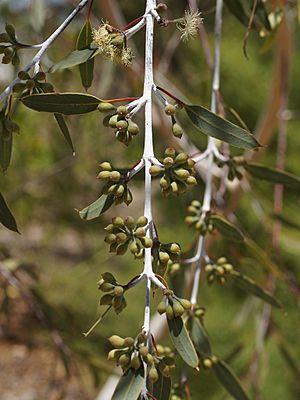Badgingarra weeping mallee facts for kids
Quick facts for kids Badgingarra weeping mallee |
|
|---|---|
 |
|
| Flowers and buds | |
| Conservation status | |
| Scientific classification | |
| Genus: |
Eucalyptus
|
| Species: |
pendens
|
The Eucalyptus pendens, also known as the Badgingarra weeping mallee, is a special type of tree. It is native to a small area on the west coast of Western Australia. This plant gets its name "weeping" because of its graceful, drooping branches.
What Does It Look Like?
This mallee usually grows to be about 2 to 5 metres (7 to 16 ft) tall. It has a slender and drooping shape, which makes it look very elegant. The bark is smooth and can be pink or grey.
The Badgingarra weeping mallee blooms between August and November. During this time, it produces beautiful white or cream-colored flowers. Its leaves are thick and dull green, shaped like a spear. They are attached to narrow, flat stems.
Naming the Weeping Mallee
A botanist named Ian Brooker was the first to officially describe this species. He did this in 1972 in a scientific journal called Nuytsia.
Brooker collected the first sample of this plant in 1969. He found it along the Brand Highway between Gingin and Badgingarra. The second part of its scientific name, pendens, comes from a Latin word. It means "pendulous" or "weeping," which perfectly describes the plant's drooping branches.
Where Does It Grow?
This rare plant is found in low scrub lands. It grows in a small area along the west coast of Western Australia. You can find it in the Wheatbelt region. This area is between the towns of Coorow, Dandaragan, and Moora.
The Badgingarra weeping mallee likes to grow on hillsides, rocky areas, and sandy plains. It prefers sandy or gravelly soils, which often contain a type of rock called laterite. Another rare plant, Johnson's mallee, is often found growing near E. pendens.


